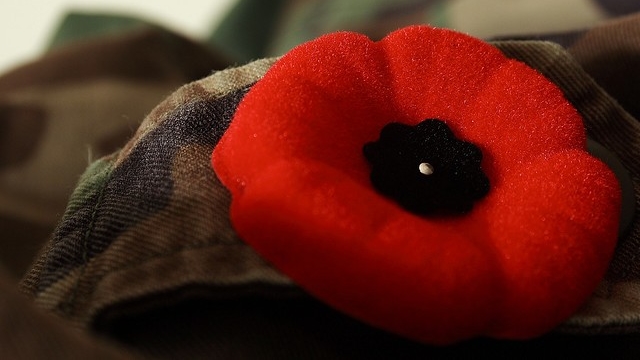"Lest We Forget"
Canada
In Canada, Remembrance Day is a public holiday and federal statutory holiday, as well as a statutory holiday in all three territories and in six of the ten provinces (Nova Scotia, Manitoba, Ontario, and Quebec being the exceptions). From 1921 to 1930, the Armistice Day Act provided that Thanksgiving would be observed on Armistice Day, which was fixed by statute on the Monday of the week in which 11 November fell. In 1931, the federal parliament adopted an act to amend the Armistice Day Act, providing that the day should be observed on 11 November and that the day should be known as "Remembrance Day".
The federal department of Veterans Affairs Canada states that the date is of "remembrance for the men and women who have served, and continue to serve our country during times of war, conflict and peace"; specifically, the First and Second World Wars, the Korean War, and all conflicts since then in which members of the Canadian Forces have participated. The department runs a program called Canada Remembers with the mission of helping young and new Canadians, most of whom have never known war, "come to understand and appreciate what those who have served Canada in times of war, armed conflict and peace stand for and what they have sacrificed for their country."
The official national ceremonies are held at the National War Memorial in Ottawa, presided over by the Governor General of Canada, any members of theRoyal Family (such as Prince Charles, Prince of Wales, in 2009),the prime minister, and other dignitaries, observed by the public. Typically, these events begin with the tolling of the Carillon in the Peace Tower, during which current members of the Canadian Forces (CF) arrive at Confederation Square, followed by the Ottawa diplomatic corps, ministers of the Crown, special guests, the Royal Canadian Legion (RCL), the royal party (if present), and the viceregal party. Before the start of the ceremony, four armed sentries and three sentinels (two flag sentinels and one nursing sister) are posted at the foot of the cenotaph.
The arrival of the governor general is announced by a trumpeter sounding the "Alert", whereupon the viceroyis met by the Dominion President of the RCL and escorted to a dais to receive the Viceregal Salute, after which the national anthem, "O Canada", is played. The moment of remembrance begins with the bugling of "Last Post" immediately before 11:00 am, at which time the gun salute fires and the bells of the Peace Tower toll the hour. Another gun salute signals the end of the two minutes of silence, and cues the playing of a lament, the bugling of "The Rouse," and the reading of the Act of Remembrance. A flypast of Royal Canadian Air Force craft then occurs at the start of a 21-gun salute, upon the completion of which a choir sings "In Flanders Fields". The various parties then lay their wreaths at the base of the memorial; one wreath is set by the Silver Cross Mother, a recent recipient of the Memorial Cross, on behalf of all mothers whose children died in conflicts in which Canada participated. The viceregal and/or royal group return to the dais to receive the playing of the Royal Anthem of Canada, "God Save the Queen", prior to the assembled Armed Forces personnel and veterans performing a march past in front of the viceroy, bringing about the end of the official ceremonies.A tradition of paying more personal tribute has emerged since erection of the Tomb of the Unknown Soldier at the War Memorial in 2000: after the official ceremony the general public place their poppies atop the tomb.
Similar ceremonies take place in provincial capitals across the country, officiated by the relevant lieutenant governor, as well as in other cities, towns, and even hotels or corporate headquarters. Schools will usually hold special assemblies for the first half of the day, or on the school day prior, with various presentations concerning the remembrance of the war dead. The largest indoor ceremony in Canada is usually held in Saskatoon, Saskatchewan, with over 9,000 gathering in Credit Union Centre in 2010; the ceremony participants include old guard (veterans), new guard (current members of the CF), and sea, army, and air cadet units.

